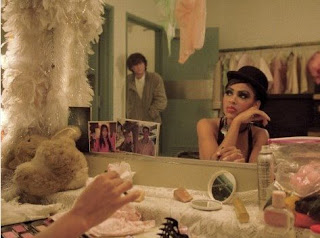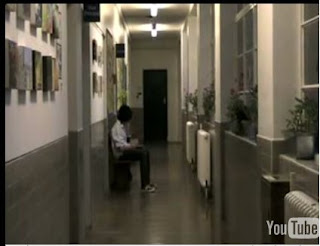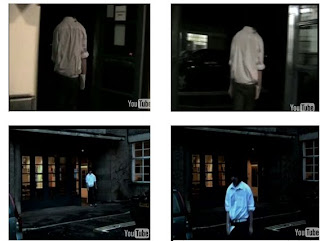| |
| T-15 FILM EXTRACT: Ram's Evaluation |
| Monday, 2 March 2009 |
| Ram's Evaluation |

For the film extract assignment our group focused on the genre of film noir; we narrowed down this broad genre to the more modern neo- noir. Our chosen genre had a lot of influence with the choices we made as a group and me as my role of cinematographer. The main aspects that were affected by our genre choice were the type of shots we used, the editing and music. The shot types we used were very “pretty” to look at, and had an artistic flare to them. This was influenced by films like “Brick” Rian Johnson, 2005 (photo  on right) and “Control” Anton Corbijin, 2007 (photo on left.) on right) and “Control” Anton Corbijin, 2007 (photo on left.)

As a group we were all involved in developing the narrative to make it a stronger, in depth piece. Using my role as cinematographer I was able to apply the main convention of neo noir, being that the type of shots are very stylish and classic looking.
I am very pleased at how well we all worked as a group, there were no conflicts and we all agreed with each other and helped develop each member’s ideas. The narrative was very easy to develop, as it is a fairly simple storyline. Our protagonist was very easy to build on, as he was a generic character type of neo- noir films. In our group, the genre didn’t really need as much developing, as we stuck to the conventions of a  neo- noir film. We made our character to be a troubled teen, who has gotten mixed up in the wrong crowd. This is shown through the fact that he’s sitting outside the head teachers office, and is being “told off” and informed on his true potential. In our sequence, we see him being followed, and finally shot. In the extract we never find out if the protagonist lives or dies, but for the rest of the film, it would be a flashback into his life a week before he got shot. Showing the audience how and why he got into the situation he’s in now. This gives an audience the opportunity to sympathise with our protagonist, or to turn against him. neo- noir film. We made our character to be a troubled teen, who has gotten mixed up in the wrong crowd. This is shown through the fact that he’s sitting outside the head teachers office, and is being “told off” and informed on his true potential. In our sequence, we see him being followed, and finally shot. In the extract we never find out if the protagonist lives or dies, but for the rest of the film, it would be a flashback into his life a week before he got shot. Showing the audience how and why he got into the situation he’s in now. This gives an audience the opportunity to sympathise with our protagonist, or to turn against him.
Throughout the planning and filming process we changed our plans a lot, even to the extent of changing our narrative. At first our narrative was too generic and very unoriginal in the way that it had been done before, several times. Our previous idea was to still have our protagonist to get shot, but this time he would be in detention, and we would show close ups of the clock, and emphasise the loud ticking noise. After looking over our synopsis again and being advised by our teacher we decided to change the narrative to something a lot stronger. Although we had drawn up a storyboard, we also tested out several different shots to see if they fit. We decided that it was better to have more footage than less; in the end we didn’t use these extra shots. Apart from the obvious change in narrative and storyline we didn’t make any other adjustments.
Being cinematographer I aimed to make the audience see that our ex tract was evidently a neo- noir based film. To do this I tried using really stylish shots, ones that would look attractive even as a still image. I used a lot of inspiration from other neo- noir films, “Brick” in particular, as the whole of our group had seen it, so it was easy to make links. I also wanted the moving shots to look modern and classy almost. The most successful moving shot, was the pan, which we had to film as I was moving backwards. To do this, I sat on a wheelchair, whilst another member of my group moved backward, whilst our protagonist walked forward. After a few attempts the shot was very triumphant. At this point of the sequence we didn’t want the audience to relate the protagonist in any way, so at points we purposely cut his head from the shot, only seeing his torso. This helped disassociate himself from any stereotype he may have been related to. tract was evidently a neo- noir based film. To do this I tried using really stylish shots, ones that would look attractive even as a still image. I used a lot of inspiration from other neo- noir films, “Brick” in particular, as the whole of our group had seen it, so it was easy to make links. I also wanted the moving shots to look modern and classy almost. The most successful moving shot, was the pan, which we had to film as I was moving backwards. To do this, I sat on a wheelchair, whilst another member of my group moved backward, whilst our protagonist walked forward. After a few attempts the shot was very triumphant. At this point of the sequence we didn’t want the audience to relate the protagonist in any way, so at points we purposely cut his head from the shot, only seeing his torso. This helped disassociate himself from any stereotype he may have been related to.

The feedback we received was not as constructive as we’d have liked, but still very complimentary and appreciated. We definitely had a problem with what time we’d film, as when we shot first, it was very dark outside, whereas when we shot second time, it was light. Our editor tried her hardest to de-saturate using the colour corrector on final cut express; which made the shot darker, but not as dark as previously, without losing our protagonist.

The fact that alongside Film studies I also study two other media orientated subjects which involve a lot of technical use, it was very easy for me as a cinematographer to use the camera, and all its functions to the best of its ability. The use of the camera, and my technical knowledge hindered our sequence in no way.
Overall I’m very pleased with our final piece, and I think as a group we worked very well. Not only creating a successful film extract but enjoying ourselves whilst doing so.
854 words
Ram.Labels: Ram Kaur |
posted by AS Film Studies Students @ 06:16  |
|
|
|
| Recent Posts |
|
| Post Archive |
|
| Post Labels |
|
|
| All FILM EXTRACT Blogs |
|
|
|
|
|

